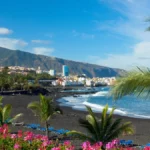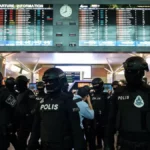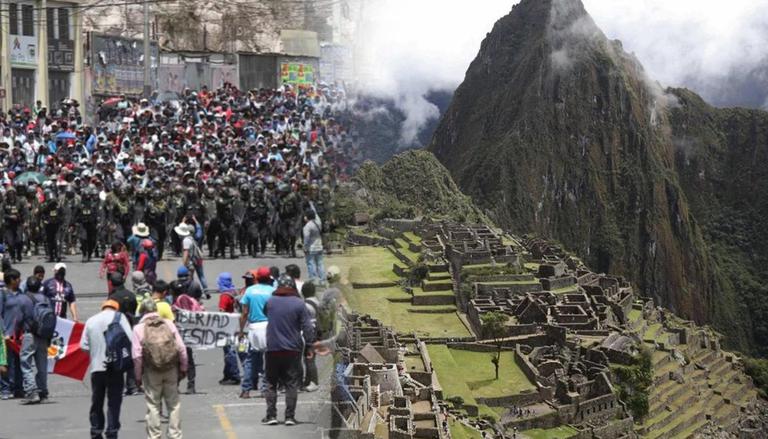About 300 tourists from around the world have been left stranded in the ancient city of Machu Picchu, according to the mayor, after Peru was plunged into a state of emergency following the ousting of the country’s president.
Former President Pedro Castillo was impeached and subsequently arrested in early December after announcing his plan to dissolve Congress. The unrest sparked by his arrest has prompted international warnings about travel to Peru.
Darwin Baca, Machu Picchu’s mayor, said that Peruvians, South Americans, Americans and Europeans are among the stranded travelers.
“We have asked the government to help us and establish helicopter flights in order to evacuate the tourists,” Baca said Friday. The only way to get in and out of the town is by train, and these services are suspended until further notice, he said.
In a ray of hope for those affected, a statement published late Friday by the Municipal District of Machu Picchu said stranded tourists were expected to be evacuated Saturday.
“The municipality, through the Tourism Unit, carries out the necessary coordination for the selection and prioritization of children and vulnerable people for the transfer on humanitarian flights, work that has been carried out in coordination with the National Police and the district Health Center,” the statement said.
Trains to and from Machu Picchu, the primary means of accessing UNESCO World Heritage Site, were halted on Tuesday, according to a statement from PeruRail, Peru’s railway operator in the south and southeast regions of the country.
“PeruRail said they are still reviewing the situation,” Baca explained.
The United States is in touch with American citizens stranded in Peru, a State Department Spokesperson told CNN on Friday.
“We are providing all appropriate consular assistance, and are monitoring the situation closely. Due to privacy and security considerations, we won’t go into further details about numbers of US citizens who have reached out,” the spokesperson added.
The US embassy in Peru said in a statement early on Friday that the Peruvian government was organizing an evacuation of foreigners from Aguas Calientes, a town that serves as the main access point to Machu Picchu.
“We will release a message with instructions as soon as the assistance plan is confirmed. Travelers located at Aguas Calientes/Machu Picchu Village should follow instructions from local authorities whether they choose to remain in place for assistance with travel to Cusco, as well as any travelers who may choose to travel by foot,” the statement added.
Food shortages in Machu Picchu
Meanwhile, Mayor Baca warned that Machu Picchu is already suffering from food shortages because of the protests, and the local economy relies 100% on tourism.
Baca called on the government, led by new President Dina Boluarte, to establish a dialogue with the local population to put an end to the social unrest as soon as possible.
PeruRail said it would assist affected passengers in changing the dates of their travel.
“We regret the inconvenience that these announcements generate for our passengers; however, they are due to situations beyond the control of our company and seek to prioritize the safety of passengers and workers,” the company said in a statement.
Peru’s Ministry of Transport said Friday that flights had resumed from the Alejandro Velasco Astete International Airport in Cusco after they were temporarily suspended amid protests in the country.
“Passengers who need to move during curfew hours may use their travel tickets as a safe-conduct,” the ministry said.
Operations to and from Alfredo Rodríguez Ballón International Airport in Arequipa remain suspended.
“LATAM maintains constant monitoring of the political situation in Peru to provide the pertinent information according to how it may impact our air operation,” LATAM Airlines Peru said in statement.
“We await the response of the relevant authorities, who must take corrective measures to ensure safety for the development of air operations.”
It added: “We regret the inconvenience that this situation beyond our control has caused our passengers and we reinforce our commitment to air safety and connectivity in the country.”
At least 20 people have died amid the political demonstrations.
Warnings from the US, the UK and Canada
The US State Department has issued a travel advisory for citizens traveling in Peru, which it has listed as a level three “reconsider travel” destination.
“Demonstrations can cause the shutdown of local roads, trains, and major highways, often without prior notice or estimated reopening timelines.
“Road closures may significantly reduce access to public transportation and airports and may disrupt travel both within and between cities,” it warns.
The State Department is asking travelers in Peru to sign up for STEP alerts from the US Embassy if they haven’t yet.
The United Kingdom’s Foreign, Commonwealth & Development Office has also warned its citizens about the situation.
“British nationals should take particular care to avoid all areas of protests. If possible, you should remain in a safe place. … You should plan ahead for severe disruption to any plans,” the FCDO said Friday evening on its website.
It also told travelers arriving in the capital, Lima, that there was no ability to travel to or from many regional areas — including Cusco and Arequipa — and that more disruptions were possible.
British nationals were also warned to respect Peruvian curfews put in place and to monitor local news and social media for more information.
Canada’s Global Affairs department has warned its citizens to “exercise a high degree of caution” in Peru and to avoid nonessential travel in numerous regions. Canada’s Global News spoke to one Canadian stuck in the small town of Ica in southern Peru, who said he’s now away from civil unrest but was robbed in a taxi.
Amy Madden, a US traveler in Peru, recounted a lengthy trek she and other stranded tourists made through the country’s Sacred Valley in an attempt to leave the area following days of unrest.
The journey included a scare when her tour group had to stop at an improvised road block in a village near Ollantaytambo on Friday, she told CNN via text message.
Once the tourists had exited the van, a group of a dozen men and some women attacked the empty vehicle, she said, with one man using a scythe to slash the tires. She and the other tourists ran away and were not harmed, she added. Another van later picked them up and took them to Ollantaytambo.
Madden said she had now made it safely to Cusco and was looking — without much luck — for flights out of the country.
While she feels safe at the moment, she’s antsy. “It’s just a lot of unknowns,” she said.
Tourists running out of medications
Another American tourist who’s stuck in Machu Picchu has run out of medication and is unsure when she’ll be able to leave the small town and get more, she told CNN.
Florida resident Kathryn Martucci, 71, was on a group trip with 13 other Americans when Peru went into the state of emergency, she said.
According to Martucci, her travel group was unable to grab the last train out of the small town before the railroad was suspended.
“They’ve been there since Monday, and now she and the other people she’s with are running out of the medications they need,” Michael Martucci said. “There’s nothing in the tiny town they’re stuck in. They’re safe and have food thankfully, but there’s no way to get more medication.”
Kathryn Martucci said her group was scheduled to stay in Machu Picchu for two days, so they were told to pack light and only bring a two-day supply of medication.
On Friday morning, Martucci said her tour guide took her group to city hall to be medically evaluated in hopes that local officials would understand their situation and help them find a way out.
“There were about 100 tourists in line, and we waited for two hours before we saw the doctor,” Martucci said. “They told me I was a priority, and that they were going to try to get me on a helicopter out of Machu Picchu in the next two days.”
Yet, Martucci is unsure whether that will happen, she told CNN.
“There are several people in need of help, and a helicopter can only carry 10 people. We don’t know what’s going on.”
Her son Michael Martucci, who lives in the United States, also spoke with CNN and has been trying to help his mother find a way out.















